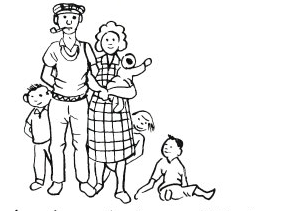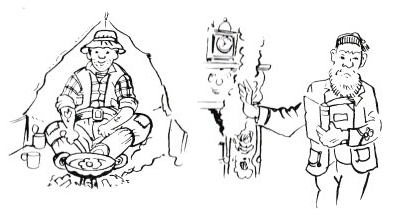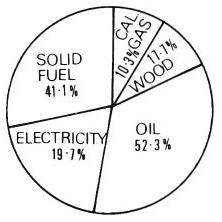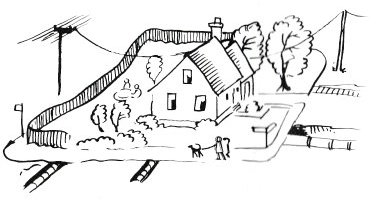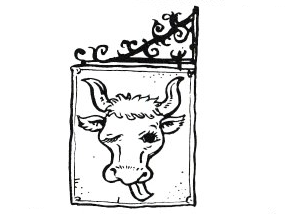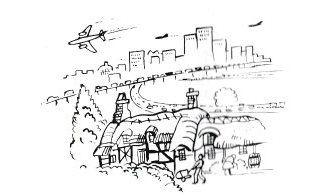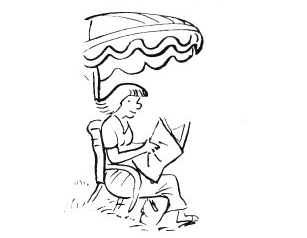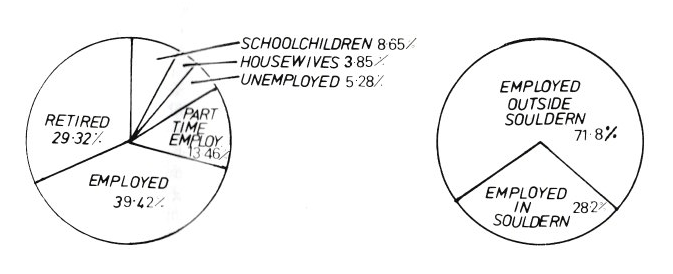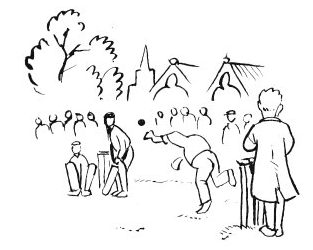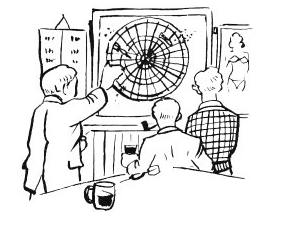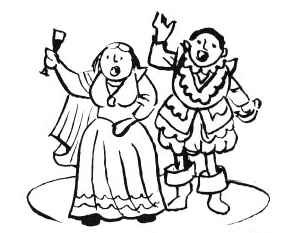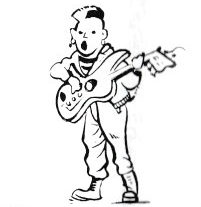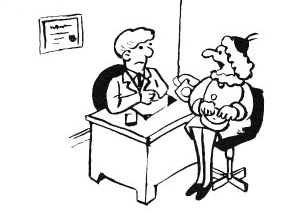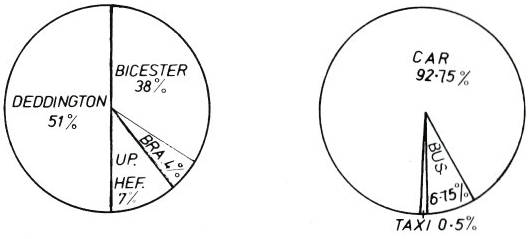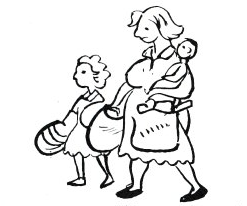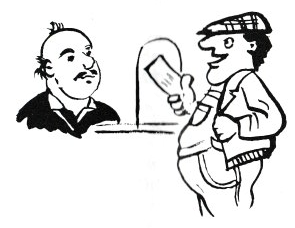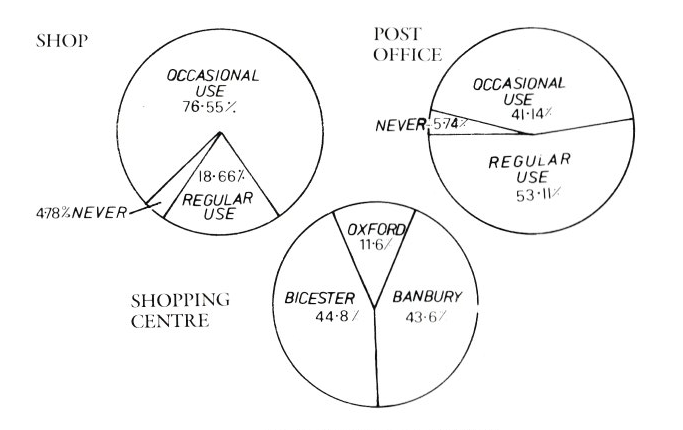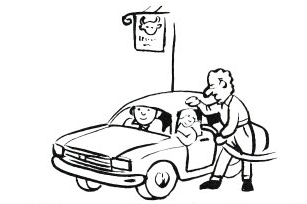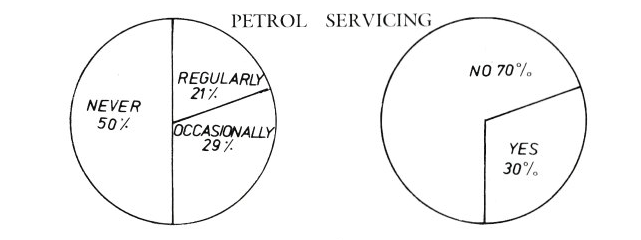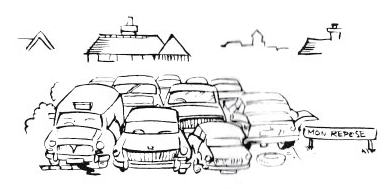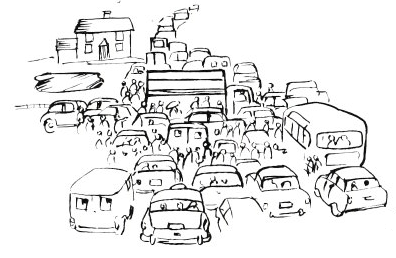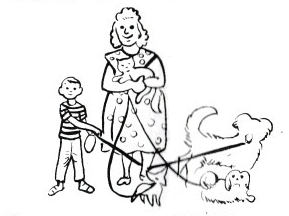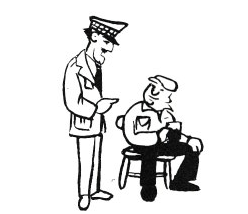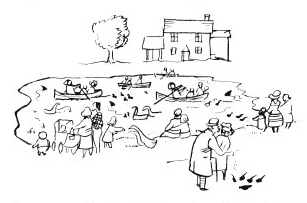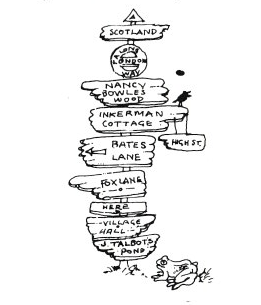self-portrait-4
THE RESPONSES
HOUSEHOLDS
Replies were received from 108 households, approximately three quarters (76.6%) of whom were living in freehold properties and just under a quarter (23.4%) in rented accommodation.
The average number of people including children living in each household was 2.74. Clearly the question of overcrowding is not the problem it was 100 years ago. The “Bicester Advertiser” for the 15th November 1889 reported a widow, Mary Lake, being summoned for occupying a house too small for its inmates, four children, a mother and grandmother, and being ordered to reduce the number by two within the space of a week!
Replies about services to houses indicated that all were served by electricity, 94% had mains water, almost 92% had a telephone and 85% were connected to the mains sewerage. The following diagram indicates the proportions using different sources of heating. It totals over 100% because some households use more than one source.
53% of the householders confirmed that if ever gas were made available in the village they would seriously consider having it connected to their homes.
60.7% of those replying confirmed that they possessed a garage but the questionnaire did not elicit the information as to whether these garages were used for sheltering cars or for other storage purposes.
Concerning vehicles, residents claimed the ownership of 141 private cars, 2 motorcycles and 86 bicycles (one at least with flat tyres). 53% of the cars are normally left in the village during the day and there were 156 car drivers.
THE PEOPLE
It should be remembered that the information in this section is based upon the questionnaires actually returned and so does not constitute a complete census. Nevertheless, replies were received from 98 men and 115 women, representing about 80% of the total village population.
As might be expected, most of the people in the parish are of a mature age with almost 66.6% over 39 years and almost 35% over 60 years old. There are just 19 children in Souldern aged 11–17 and less than 40 people under 30 years of age.
ANALYSIS OF AGE GROUPS
| Age | Number | % | Total |
|---|---|---|---|
| 11–17 | 19 | 8.92 | 8.92 |
| 18–29 | 20 | 9.39 | 18.31 |
| 30–39 | 32 | 15.02 | 33.33 |
| 40–49 | 41 | 19.25 | 52.58 |
| 50–59 | 27 | 12.68 | 65.26 |
| 60–69 | 37 | 17.37 | 82.63 |
| 70–79 | 24 | 11.27 | 93.90 |
| 80–89 | 13 | 6.10 | 100.00 |
Bearing in mind the age profile for the village, we are nevertheless a fit community. Just 6 persons are officially registered as disabled and 3 are blind or partially sighted.
One in three families (54) in Souldern today has its roots deep in the past. Indeed, one family was establishing itself here as far back as 1689, a time when William III and Mary II had just come to the throne and the cost of living was very different. A look in the history books shows that meat then cost 3d a pound, bacon 4d, good cheese 2d and draught ale 2d a flagon. Coffee, by contrast, was very expensive at 3s 6d a pound and tea could cost up to 3 guineas a blend.
1733 is the date cited by a second resident as the year in which Souldern became the home for her family. By then George II was on the throne. Cockfighting was a regular pastime during this period and gin drinking was ‘out of control’ according to the historians. Indeed, Oxford had an alehouse for every 60 persons! In 1889 a local newspaper reported a petition signed by 74 villagers against a renewal of the licence of the Bulls Head public house (now the garage) on the grounds that a village of under 500 was already adequately served by four pubs and a beer house, without the need for a sixth!
A further two dozen Souldern families go back more than one hundred years, which must be quite a record when it is considered how much villages are changing today with fewer and fewer jobs in the countryside.
The most recent families to move into Souldern, at the time of the questionnaire, have been in the village for just 2 months and they join more than a dozen who report that they moved into the parish during the last 9 months. Over 30 people have lived in Souldern less than 2 years.
Interestingly, once families move to the village they tend to stay. Almost 40 people have lived in Souldern between 6 and 10 years and 32 people indicated they have made their home here for between 11 and 20 years. Over 50 people have lived here between 20 and 50 years. Perhaps the peace and quiet and honest friendliness of our village are just a few of the reasons.
EMPLOYMENT
Up until the first World War the pattern of employment in Souldern, as in most English villages, must have changed remarkably little in the previous several hundred years. They were all of necessity largely self sufficient in providing for the economic needs of their residents, the only contact with the local towns being with the village carrier in his horse drawn van or by train. The majority of males worked on the land as farm labourers or gardeners, but there were also tradesmen such as builders, blacksmiths, saddlers, cobblers, as well as the carpenter who doubled as wheelwright and undertaker. Added to these would be the teachers, the parson and the priest, and a postman who walked to and from Aynho station three times daily except on Sundays. Younger women worked mainly as domestic servants until they married; all the larger houses employed one or more. It was unusual for married women to work outside the home but lacemaking provided meagre pinmoney for some and a few would take in washing and ironing for the better off.
Souldern Manor was a major employer, with grooms, gardeners and several indoor staff, while Manor Farm had as many as ten men and boys all the year round. The smaller farms tended to be worked by the owner and his family, but in addition accounted for an extra six or seven workmen. All the larger houses had one or more gardeners and maids. Older residents remember that it was not uncommon to see a dozen or so young men kicking a ball about in the main street during their dinner hour, there being no traffic to worry about.
The Appraisal reveals what a big change has occurred during the last sixty or seventy years. The first pie diagram shows the employment situation today. There has been a big influx of retired people who now make up approximately one in three of the residents, while the proportion of children is much less; Bob Hitchman remembers that he was one of about eighty on the school roll in his day.
The small fraction describing themselves as housewives is probably an indication that many young mothers now have jobs. One in twenty is unemployed. The second pie diagram shows the proportion of those working in the village compared with those who have to travel to their place of work. Here is the big change in the pattern, revealing that most by far travel out of Souldern, but surprisingly there are still 31 jobs in the village, but presumably most of these are for women. Of those who travel most do so by car, or by car and train, while some nine use buses.
LEISURE
Replies to the questionnaire paint the picture of a village of active and involved inhabitants. For its size and position, Souldern is well served by, and gives support to, organisations and facilities such as the Church, the Chapel, the two public houses, the Village Hall Committee, the Horticultural Society, the playing field and the recently established Nancy Bowles Wood.
Leisure and social activities referred to by respondents (representing four fifth of villagers) include the following:
| Activity | Based in Souldern |
Based outside Souldern |
|---|---|---|
| Allotment Holders | 23 | – |
| Church and Chapel | 52 | 14 |
| Drama and Music Groups | – | 9 |
| Football Club | 6 | 3 |
| Guides | – | 2 |
| Horticultural Society | 76 | 2 |
| Local History | – | 5 |
| Mothers Union | 11 | 1 |
| Pub and Social Groups | 26 | 9 |
| Sports Groups | 2 | 24 |
| Village Committees | 43 | – |
| Women's Institute | – | 2 |
The membership of village committees, even though a number of individuals will be members of more than one, does reflect on the commendably wide involvement of people in communal village life. A number of respondents mentioned belonging to various outside associations and groups; these are listed in the Appendix B.
Among those who replied considerable interest was expressed in local history, while 28 requested further information about existing groups and organisations. A list of addresses and points of contact is listed in the Appendix C.
A number of replies expressed concern about the lack of provision for young people. “What has happened to the Youth Club?” “Those aged 7-15 are not catered for". “There isn't anything to do in Souldern”. “We should have more things for young and teenaged children because we have nothing because people don't think of us because there are so many old people in the village". These reflect some of the comments made by teenage respondents.
Several people listed the Nancy Bowles Wood as a growing asset for leisure. “The Nancy Bowles Wood is a great catalyst and a great triumph for the whole community … Projects like that should be encouraged” are typical examples of this point of view, although there were critical comments about the sometimes muddy state of the approach and the lack of parking space at the foot of the path. Some enjoyed the opportunity the location of the village provides for country walks and requested details of the footpaths. We have provided a map of the definitive paths as approved by the County Council and as existing in the winter of 1989/90.
Twenty nine people confirmed that they made regular use of the library van and a further 87 used libraries elsewhere, at schools, at their place of employment and in neighbouring towns.
Twenty four villagers attend adult education classes at the following centres:
| Banbury | 4 |
| Bicester | 9 |
| Deddington | 4 |
| Oxford | 2 |
| Elsewhere (including Upper Heyford) |
5 |
Overall, the responses to the questionnaire give a portrait of a village in which, in spite of its small size and relative isolation, its inhabitants live an active community and leisure life. This is a picture which is confirmed by a glance at any time at the village noticeboard or by a reading of any copy of that excellent monthly news sheet, “The Three Parishes". This publication should provide any future social historians with a very comprehensive picture of the life of the village at this period of time.
SERVICES AND FACILITIES
Medical
The questionnaire posed two questions on this subject: “Which medical centre do you use?” and “How do you travel to medical appointments?”
Of the 212 replies to the first question, 81 indicate that they use Bicester medical centre, 108 use Deddington, 8 use Brackley and 15 use Upper Heyford. Of the 207 replies to the second question, 192 travel to medical appointment by car, 14 by bus and 1 by taxi. (A reflection on the availability of public transport in this area?).
Amongst the comments received was a request for a mini-bus to enable those without their own transport to visit friends in hospitals and homes nearby.
Shopping
This analysis of the shopping section of the questionnaire return is based on replies from 213 residents.
The results are illustrated in 3 diagrams set out on the next page. The first shows the extent to which the villagers make use of the general provision section of the store, the second of the Post Office side, and the third indicates which are the preferred towns for major purchases. From the first we see that I in 20 never use the shop; 3 in 4 use it occasionally and only 1 in 5 make it their principal source of groceries. This is a surprisingly poor support, but of course many non-villagers also make their purchases here, and not every resident made a return anyway. The recent closing of Aynho shop presumably brought some extra business. From the second Pie diagram we see that the Post Office side is much better supported by the village, with over half the returns indicating regular use, 41% occasionally and only about 6% never using it at all. The third diagram shows, not surprisingly, that Bicester and Banbury are about equally favoured as shopping centres, but with Oxford attracting some 12% of the business. Perhaps these people work in Oxford and find it easier to shop there.This pattern of shopping contrasts very sharply with that of 70 or so years ago as Bob Hitchman attests in his writings. At that time the village depended almost entirely on its own shops. With labourers' wages at sixteen shillings weekly and even a bicycle a luxury, the housewife with a family was to a large extent a prisoner in her home. Anything not available in the village could be collected by one of the two carriers who made regular bi-weekly journeys to Banbury and Bicester, charging two old pence per item for the service, but according to size for bigger things. Mr Bates of West End was one carrier, Mr Lett of Timber Cottage the other. Both used horse drawn vans. There were three grocers in the village; the Boddingtons of Great House Close were butchers and bakers and also sold sweets and other items in their shop. The Titcombs were bakers as well as grocers; their shop was in the premises now occupied by the Bull's Head Garage. The third grocer was in what is now Deep Well Cottage, rented from the Gough family by King's of Syresham; this shop supplied groceries and paraffin among other things. The Boddingtons and Titcombs were also smallholders, the former producing animals for their own butchery business on the land to the rear of the shop, while the Titcombs rented the fields known as Poor's Allotment (on either side of the Clap Gate bridle path) from Souldern Charities.
Thankfully since those days the village has become much more affluent and in addition there has been a significant influx of retired folk who have their own transport, the car. The supermarkets too have arrived in the local towns, with their aggressive marketing techniques, wide choice and low margin sales, allowing them to sell at prices which no small business could match, hence their attraction, with the added advantage that the home refrigerator/freezer makes it possible to buy food in large quantities at longer intervals. Thus a once weekly visit to the local town is enough for most people. It is not at all clear how any village stores can survive in this fiercely competitive situation, yet at the same time it has to be said that they perform a unique and invaluable function in any village.
Certainly, Souldern villagers appear to be very appreciative of the range of goods and services offered and of the excellent personal service provided by the staff of the village shop. It was mentioned as one of the things valued by a number of respondents.
The Village Garage
Two questions were asked in the questionnaire on this subject:
“Do you buy petrol in the village?” and “Do you have your car serviced in the village?"
Amongst the 194 who replied to the first question, 42 claimed to buy petrol regularly from the village garage, 57 occasionally and 95 never. Of the 187 who replied to the second question, 57 have their cars serviced in the village and 130 elsewhere.
When considering these figures, it should be borne in mind that there are a number of business cars in the village, many of which will have petrol and servicing accounts at major garages in Bicester, Banbury and elsewhere. Some privately owned cars are tied to manufacturers appointed agents, which are located outside the village.
A number of respondents said they would use the village garage more if unleaded petrol and diesel fuel were available.
The Parish Council
A large majority of the comments on the Parish Council were appreciative of its work on behalf of the village: “I value the continuing efforts of the Parish Council and others to keep the title ‘Best Kept Village’”; “I value the public spiritedness of the P.C.”; “We are lucky to have an excellent Parish Council and we do not need to invite bureaucracy.” These are three typical comments, though one respondent felt that the Council could do more to influence the planners not to allow new developments in the village out of keeping with the village's character.
HOUSING
Of the 210 people replying to the questionnaire, only 4% failed to answer the first part of this section. 46% did not want more housing in the village at all, 27% did not mind and 23% said they would like to see more housing, although there were constant provisos as to the type of housing which would be acceptable, where it was to be built and for whom.
Somewhat fewer replied to the second part as to what kind of housing the village needs, and there was some doubt expressed that any needs existed. Someone asked, “What needs?”, whilst another would have no objections to development, … “provided it was tastefully done in character with the village, but frankly I don't think it is necessary, is it?” There is little doubt that the question of future housing development is the one which arouses most concern and evokes widely differing views.
However, 47% thought that housing for young people was needed while 22% saw a need for housing suitable for old people. Both rented and Council housing attracted 10% of the returns and 5% wanted the provision of flats or bedsitters. Two comments which represent this concern were quite explicit. “… there are obviously not enough bungalows provided here — I know some people like to stay put, but if those who wished to take smaller units could be provided with some, the family houses could be re-let and some of the younger people could continue to live here, and so even out the balance, as this village is fast becoming a community of the very rich and elderly folk, and not many in the younger and middle age group are able to stay here”. And again “… we badly need more rented accommodation and low-cost housing. Otherwise the village will become an elephant's graveyard with no-one to keep the community going as a working village… we must not become a retirement suburbia…”
Objections to any development whatsoever were registered by 20% of those replying, some of these objections being couched in very strong terms indeed. Two fairly typical replies were: “I would particularly oppose any development of the village which would without doubt destroy its unique character. Should that happen, I would certainly move as would, I think, many others”, and “I personally would fight to stop developers coming in and knocking down old houses etc., to build. The new should be built around Souldern, if it's really necessary”.
Although 61% would have no objections to a development to meet local needs, there were again strong feelings expressed as to the suitability of building, the site and user groups; almost all these affirmative replies had some such rider, the main concerns being that any development should not spoil the village in any way, nor attract those who would not take part in village life. There was also some resistance to the extra facilities, such as more shops or a bigger garage, which such a development might bring with it, and the potential difficulties of access and danger of over-crowded roads were also mentioned.
The failure of 18.5% to reply to this part of the questionnaire at all may point to an error in drafting the questionnaire; there was evidence that the questions were not always fully understood.
The feelings predominating among those who did reply seem to be summed up by one comment in reply to question 14: “Let us not make the common mistake of allowing modern house construction and design to be built on the several building plots presently available. With the advent of the M40 more people will be looking for property in the area. We must not let any new residents change the village either by development or by services, i.e. another shop, larger garage, supermarket or any form of public entertainment”.
There is reflected in the replies a general awareness of the conflict between the need for some additional accommodation for young and old to be able to live in their home village and the fact that any commercial development would be unlikely to help local families as the costs would be prohibitive. So yet more strangers would become residents, resulting in more pressures for change. As one respondent put it “…something needs doing, but, there, I don't know what!”
ROAD SAFETY
The question of road safety provoked a tremendous response. Out of a total of 213 individual questionnaires completed no less than 92 offered a total of 147 comments on the problem of road safety.
Thirty six referred to the danger inherent in parking on the hill between the A41 junction and the pond, and 30 were concerned about the excessive speed of traffic in the village, particularly of that coming down the hill towards the pond. Many commented on the dangerous junction at the pond and the vulnerability of children playing there. Nineteen suggested “Sleeping Policemen” be installed at appropriate places and nine called for a one way system, particularly along Back Lane and Fox Lane.
This comment was representative of many: “… a dangerous lack of visibility at the exit into the staggered crossroads by the pond. To prevent serious accidents and improve vehicular circulation it is necessary to make Back Lane one way from the pond to Fox Lane”.
Eight suggested a “Drive Carefully” sign at the entrance to the village, seven suggested provision of a car park with parking banned on the hill, six suggested a mirror at the pond junction, four referred to the dangers of stones implanted in verges, two suggested a “No Through Road” sign, and finally there was a suggestion that there should be a traffic filter on the A41 at the village junction.
Without doubt a very large number of villagers are concerned about road safety in Souldern and fear that before long there will be a serious accident in the village.
ISSUES OF CONCERN
The subject which prompted the second largest response (93) was the lack of street lighting in the village, but opinion was well divided with 52 in favour and 41 against. Twelve referred particularly to the safety aspect; it is clear from certain replies that some lady residents are afraid to leave their homes after dark. “Women out alone would feel safer with street lighting after dark”. There was also mention of the area between the village hall and the pond as being particularly dark at night.
There were 69 comments on the subject of street names, 39 in favour of their being displayed and 30 against. No clear consensus here! “I’m continually asked the way by delivery van drivers and except for the High Street the other little roads are confusing". On the question of the identification of houses, of 54 replies 36 were in favour of displayed identification (most preferring house names to numbers) and 18 were against.
There were 64 responses on the question of dog nuisance. Of these 55 objected (some very strongly) to dogs fouling the streets, verges and other areas of the village, particularly the recreation ground. “I would like horse and dog owners to be much more aware and to clear up after their animals … it is a health hazard, particularly to the young”. Only 9 felt there was no cause for concern. “As this is a country village why can't people stop fussing about dogs — what nuisance? The odd mess isn't going to kill any of us”.
Finally, there were 34 replies on the subject of Policing. The majority (28) felt there should be greater police presence in the village, 6 specifically wanting our own village bobby. “It would be an asset to re-establish a village policeman (or policewoman!) to whom we can talk and readily recognise. Someone who knows the village residents and local problems”. Only 6 respondents expressed themselves as being satisfied with the existing police coverage.
OTHER COMMENTS
One group of questions asked “What would you like to see changed in Souldern? What would you fight to preserve? What do you value in the village?” These produced a large response with 281 individual comments in all.
On the subject of changes there were 97 replies of which an overwhelming majority (69) want no change at all! A number of those wanting change or improvement referred to green issues.
“Perhaps more seats could be provided around the village … Perhaps at least one of the old pond sites could be rejuvenated to hold wild life and a suitable waterside habitat. I would like to the maintenance of areas specifically for wild life with perhaps a bit less emphasis on arid mown areas of prairie grass". Nine responders wanted more trees in the village, four more bridleways, three wanted a ban on bonfires, two wanted bus shelters and two wanted waste recycling facilities. “These services could cater for re-cycling bottles, aluminium and tin cans and paper. Containers for such a purpose could be positioned in a centrally located and easily accessible location, e.g. behind the shop”.
Two people wanted Upper Heyford Air Base removed and one each want a village school, a golf course, meals-on-wheels, sign posting of all paths, a post box in the area of Bovewell, more litter bins, quieter delivery van visits in the early morning, and a central TV aerial serving all houses. On the subject of what is valued in the village, there were 184 replies with a much wider spread of opinion. First and foremost, 41 value the character of the village and 28 the friendliness of the residents. Twenty-six appreciate its quietness and 18 the fact that the village is sited as a “No Through Road”. Seventeen particularly mentioned the service of the Post Office Stores and 13 the part played by the village church. Ten mentioned the value of the garage, eight the Nancy Bowles Wood, five the Fox Inn, four the Village Hall, three the footpaths and one the mobile vans which visit the village. Six respondents objected to the noise from Upper Heyford Air Base and four considered the bus service inadequate.
